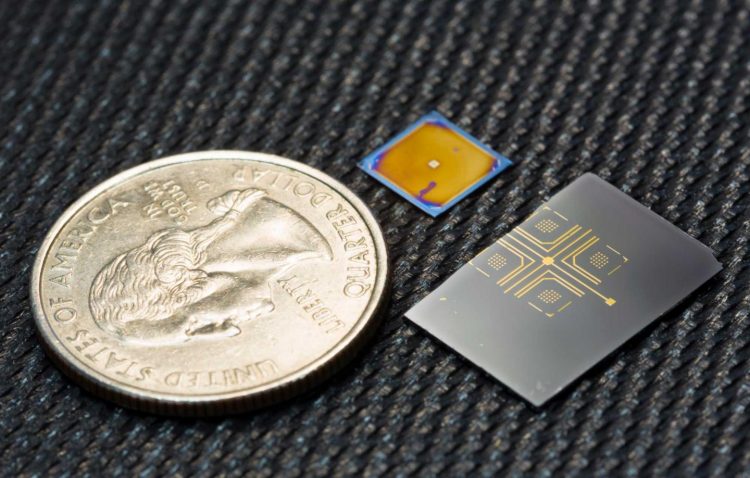Metamaterial uses light to control its motion

This is an optically-driven mechanical oscillator fabricated using a plasmomechanical metamaterial. Credit: UC San Diego Jacobs School of Engineering
This work demonstrates a metamaterial-based approach to develop an optically-driven mechanical oscillator. The device can potentially be used as a new frequency reference to accurately keep time in GPS, computers, wristwatches and other devices, researchers said. Other potential applications that could be derived from this metamaterial-based platform include high precision sensors and quantum transducers. The research was published Oct. 10 in the journal Nature Photonics.
Researchers engineered the metamaterial-based device by integrating tiny light absorbing nanoantennas onto nanomechanical oscillators. The study was led by Ertugrul Cubukcu, a professor of nanoengineering and electrical engineering at the University of California San Diego. The work, which Cubukcu started as a faculty member at the University of Pennsylvania and is continuing at the Jacobs School of Engineering at UC San Diego, demonstrates how efficient light-matter interactions can be utilized for applications in novel nanoscale devices.
Metamaterials are artificial materials that are engineered to exhibit exotic properties not found in nature. For example, metamaterials can be designed to manipulate light, sound and heat waves in ways that can't typically be done with conventional materials.
Metamaterials are generally considered “lossy” because their metal components absorb light very efficiently. “The lossy trait of metamaterials is considered a nuisance in photonics applications and telecommunications systems, where you have to transmit a lot of power. We're presenting a unique metamaterials approach by taking advantage of this lossy feature,” Cubukcu said.
The device in this study resembles a tiny capacitor–roughly the size of a quarter–consisting of two square plates measuring 500 microns by 500 microns. The top plate is a bilayer gold/silicon nitride membrane containing an array of cross-shaped slits–the nanoantennas–etched into the gold layer. The bottom plate is a metal reflector that is separated from the gold/silicon nitride bilayer by a three-micron-wide air gap.
When light is shined upon the device, the nanoantennas absorb all of the incoming radiation from light and convert that optical energy into heat. In response, the gold/silicon nitride bilayer bends because gold expands more than silicon nitride when heated. The bending of the bilayer alters the width of the air gap separating it from the metal reflector. This change in spacing causes the bilayer to absorb less light and as a result, the bilayer bends back to its original position. The bilayer can once again absorb all of the incoming light and the cycle repeats over and over again.
The device relies on a unique hybrid optical resonance known as the Fano resonance, which emerges as a result of the coupling between two distinct optical resonances of the metamaterial. The optical resonance can be tuned “at will” by applying a voltage.
The researchers also point out that because the plasmomechanical metamaterial can efficiently absorb light, it can function under a broad optical resonance. That means this metamaterial can potentially respond to a light source like an LED and won't need a strong laser to provide the energy.
“Using plasmonic metamaterials, we were able to design and fabricate a device that can utilize light to amplify or dampen microscopic mechanical motion more powerfully than other devices that demonstrate these effects. Even a non-laser light source could still work on this device,” said Hai Zhu, a former graduate student in Cubukcu's lab and first author of the study.
“Optical metamaterials enable the chip-level integration of functionalities such as light-focusing, spectral selectivity and polarization control that are usually performed by conventional optical components such as lenses, optical filters and polarizers. Our particular metamaterial-based approach can extend these effects across the electromagnetic spectrum,” said Fei Yi, a postdoctoral researcher who worked in Cubukcu's lab.
###
Full paper: “Plasmonic metamaterial absorber for broadband manipulation of mechanical resonances.” Authors of the study are: Hai Zhu and Fei Yi, University of Pennsylvania; and Ertugrul Cubukcu, UC San Diego.
This work was supported by the National Science Foundation Electrical, Communications and Cyber Systems division (grant ECCS-1632797).
Media Contact
All latest news from the category: Power and Electrical Engineering
This topic covers issues related to energy generation, conversion, transportation and consumption and how the industry is addressing the challenge of energy efficiency in general.
innovations-report provides in-depth and informative reports and articles on subjects ranging from wind energy, fuel cell technology, solar energy, geothermal energy, petroleum, gas, nuclear engineering, alternative energy and energy efficiency to fusion, hydrogen and superconductor technologies.
Newest articles

NASA: Mystery of life’s handedness deepens
The mystery of why life uses molecules with specific orientations has deepened with a NASA-funded discovery that RNA — a key molecule thought to have potentially held the instructions for…

What are the effects of historic lithium mining on water quality?
Study reveals low levels of common contaminants but high levels of other elements in waters associated with an abandoned lithium mine. Lithium ore and mining waste from a historic lithium…

Quantum-inspired design boosts efficiency of heat-to-electricity conversion
Rice engineers take unconventional route to improving thermophotovoltaic systems. Researchers at Rice University have found a new way to improve a key element of thermophotovoltaic (TPV) systems, which convert heat…



